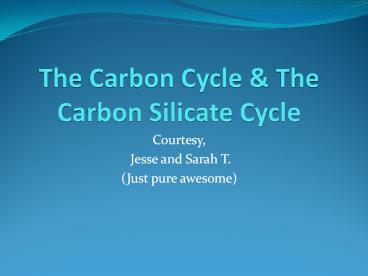The Carbon Cycle & The Carbon Silicate Cycle - PowerPoint PPT Presentation
1 / 16
Title:
The Carbon Cycle & The Carbon Silicate Cycle
Description:
Courtesy, Jesse and Sarah T. (Just pure awesome) Forms of carbon .038% of the atmosphere is carbon dioxide In the ocean there is carbonate, bicarbonate, and other ... – PowerPoint PPT presentation
Number of Views:72
Avg rating:3.0/5.0
Title: The Carbon Cycle & The Carbon Silicate Cycle
1
The Carbon Cycle The Carbon Silicate Cycle
- Courtesy,
- Jesse and Sarah T.
- (Just pure awesome)
2
Lets start with the Carbon Cycle
3
Forms of carbon
- .038 of the atmosphere is carbon dioxide
- In the ocean there is carbonate, bicarbonate, and
other forms of dissolved inorganic carbon - Carbon dioxide is also in sedimentary rock such
as limestone
4
The Definition (Get ready for this one)
- The Carbon Cycle is the global circulation of
carbon from the environment to living organisms
and back to the environment - Lets break this up into 3 simple steps
5
Step 1
- During photosynthesis, plants, algae, and certain
kinds of bacteria remove carbon dioxide from the
air and fix (or incorporate) it into chemical
compounds like sugar
6
Step 2
- The compounds formed through Photosynthesis are
used by the producers or the consumers that eat
the producers for cellular resparation
7
Step 3
- Decomposers break down other organisms and
through cellular respiration return carbon
dioxide back to the atmosphere
8
Fossil Fuel
- Coal, natural gas, and oil formed from remains of
ancient organisms, are vast deposits of carbon
compounds (Id say these items are quite useful
in todays age) - The carbon is returned to the atmosphere when the
fuels are burned (very green, wouldnt you say?)
9
Heres a Nifty Picture!
10
Now we can move onThe Carbon Silicate Cycle
What is it?
- The Carbon Silicate Cycle is when the Carbon
Cycle interacts with the Silicate Cycle over
millions years
11
How does it start?
- Chemical weathering processes
- Atmospheric carbon dioxide dissolves in rain
water (yum) forming carbonic acid (dont eat
that). As this weak acid moves through the soil,
it dissociates to create hydrogen ions and
bicarbonate ions - When hydrogen ions enter silicate rich minerals
such as feldspar, they interact and release
calcium ions
12
What Happens Next, You Ask?
- The calcium and bicarbonate ions eventually reach
the ocean (I like the ocean, dont you?) - Then, microscopic marine life use them to make
their shell - When the marine organisms die (poor snails) their
shells sink to the ocean floor, are covered by
sediment, and then form very thick carbonate
deposits
13
Final Product (its about time)
- Eventually, the deposits form sedimentary rock,
such as limestone (People have used this to build
for thousands of years!) - Sometimes, (lifameem in Hebrew), this rock at the
bottom of the ocean will be lifted that is why
the summit of Mount Everest is made of
sedimentary rock (who knew!?)
14
And it Continues (contain your excitement)
- Once the sedimentary rock is exposed, chemical
weathering process returns carbon dioxide to the
atmosphere and water - The cycle begins anew, so lets go over it again
(jokes)
15
We Just Love Pictures
16
We Hoped You Learned Something New! ( while
being mildly entertained, of course)































